Evaluating Leadership Styles and CSR Benefits at Premier Inn
VerifiedAdded on 2023/06/12
|12
|5023
|211
Report
AI Summary
This report provides an analysis of leadership styles and corporate social responsibility (CSR) within the context of Premier Inn. It critically evaluates various leadership styles, including democratic, autocratic, laissez-faire, and strategic leadership, assessing their suitability for Premier Inn's operational environment, concluding that the company primarily uses autocratic leadership. The report further examines how organizational responsibility and responsible leadership contribute to corporate leadership systems, fostering a competitive advantage. Additionally, it assesses the benefits of CSR for Premier Inn and the wider community, highlighting its potential to influence stakeholder relations, improve manufacturing and delivery practices, and promote long-term sustainable business models. The document is available on Desklib, a platform offering a range of study tools and solved assignments for students.
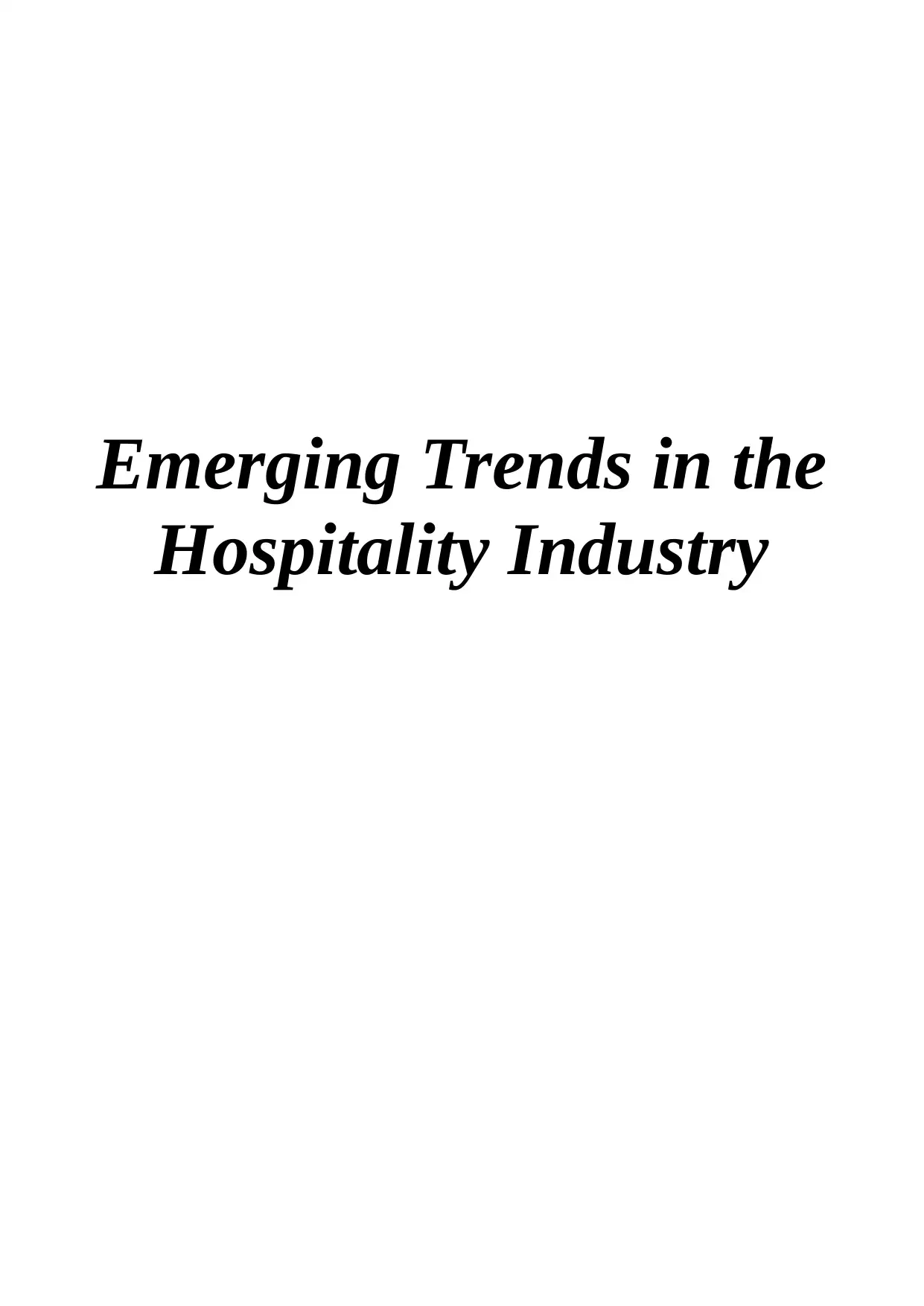
Emerging Trends in the
Hospitality Industry
Hospitality Industry
Paraphrase This Document
Need a fresh take? Get an instant paraphrase of this document with our AI Paraphraser
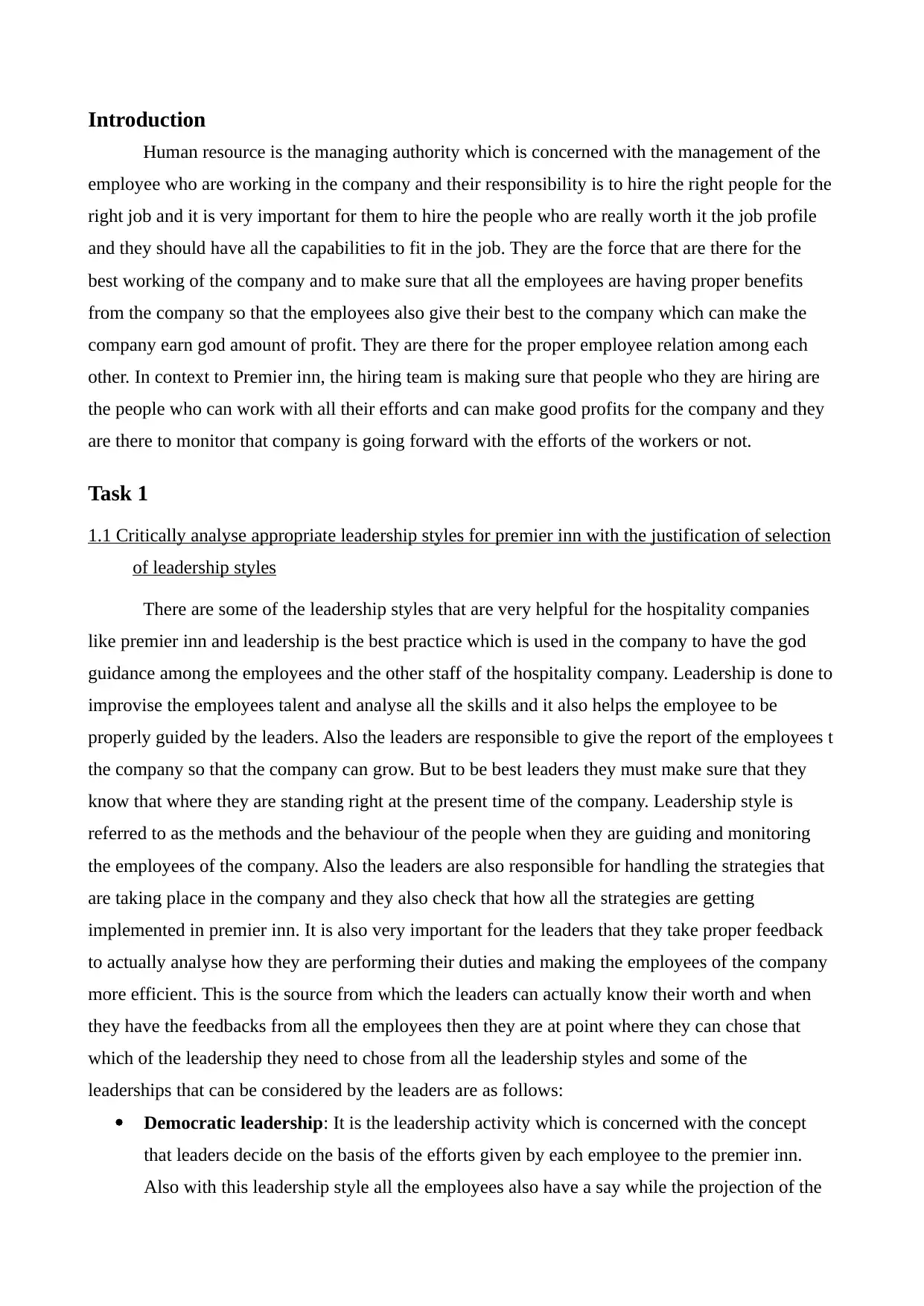
Introduction
Human resource is the managing authority which is concerned with the management of the
employee who are working in the company and their responsibility is to hire the right people for the
right job and it is very important for them to hire the people who are really worth it the job profile
and they should have all the capabilities to fit in the job. They are the force that are there for the
best working of the company and to make sure that all the employees are having proper benefits
from the company so that the employees also give their best to the company which can make the
company earn god amount of profit. They are there for the proper employee relation among each
other. In context to Premier inn, the hiring team is making sure that people who they are hiring are
the people who can work with all their efforts and can make good profits for the company and they
are there to monitor that company is going forward with the efforts of the workers or not.
Task 1
1.1 Critically analyse appropriate leadership styles for premier inn with the justification of selection
of leadership styles
There are some of the leadership styles that are very helpful for the hospitality companies
like premier inn and leadership is the best practice which is used in the company to have the god
guidance among the employees and the other staff of the hospitality company. Leadership is done to
improvise the employees talent and analyse all the skills and it also helps the employee to be
properly guided by the leaders. Also the leaders are responsible to give the report of the employees t
the company so that the company can grow. But to be best leaders they must make sure that they
know that where they are standing right at the present time of the company. Leadership style is
referred to as the methods and the behaviour of the people when they are guiding and monitoring
the employees of the company. Also the leaders are also responsible for handling the strategies that
are taking place in the company and they also check that how all the strategies are getting
implemented in premier inn. It is also very important for the leaders that they take proper feedback
to actually analyse how they are performing their duties and making the employees of the company
more efficient. This is the source from which the leaders can actually know their worth and when
they have the feedbacks from all the employees then they are at point where they can chose that
which of the leadership they need to chose from all the leadership styles and some of the
leaderships that can be considered by the leaders are as follows:
Democratic leadership: It is the leadership activity which is concerned with the concept
that leaders decide on the basis of the efforts given by each employee to the premier inn.
Also with this leadership style all the employees also have a say while the projection of the
Human resource is the managing authority which is concerned with the management of the
employee who are working in the company and their responsibility is to hire the right people for the
right job and it is very important for them to hire the people who are really worth it the job profile
and they should have all the capabilities to fit in the job. They are the force that are there for the
best working of the company and to make sure that all the employees are having proper benefits
from the company so that the employees also give their best to the company which can make the
company earn god amount of profit. They are there for the proper employee relation among each
other. In context to Premier inn, the hiring team is making sure that people who they are hiring are
the people who can work with all their efforts and can make good profits for the company and they
are there to monitor that company is going forward with the efforts of the workers or not.
Task 1
1.1 Critically analyse appropriate leadership styles for premier inn with the justification of selection
of leadership styles
There are some of the leadership styles that are very helpful for the hospitality companies
like premier inn and leadership is the best practice which is used in the company to have the god
guidance among the employees and the other staff of the hospitality company. Leadership is done to
improvise the employees talent and analyse all the skills and it also helps the employee to be
properly guided by the leaders. Also the leaders are responsible to give the report of the employees t
the company so that the company can grow. But to be best leaders they must make sure that they
know that where they are standing right at the present time of the company. Leadership style is
referred to as the methods and the behaviour of the people when they are guiding and monitoring
the employees of the company. Also the leaders are also responsible for handling the strategies that
are taking place in the company and they also check that how all the strategies are getting
implemented in premier inn. It is also very important for the leaders that they take proper feedback
to actually analyse how they are performing their duties and making the employees of the company
more efficient. This is the source from which the leaders can actually know their worth and when
they have the feedbacks from all the employees then they are at point where they can chose that
which of the leadership they need to chose from all the leadership styles and some of the
leaderships that can be considered by the leaders are as follows:
Democratic leadership: It is the leadership activity which is concerned with the concept
that leaders decide on the basis of the efforts given by each employee to the premier inn.
Also with this leadership style all the employees also have a say while the projection of the
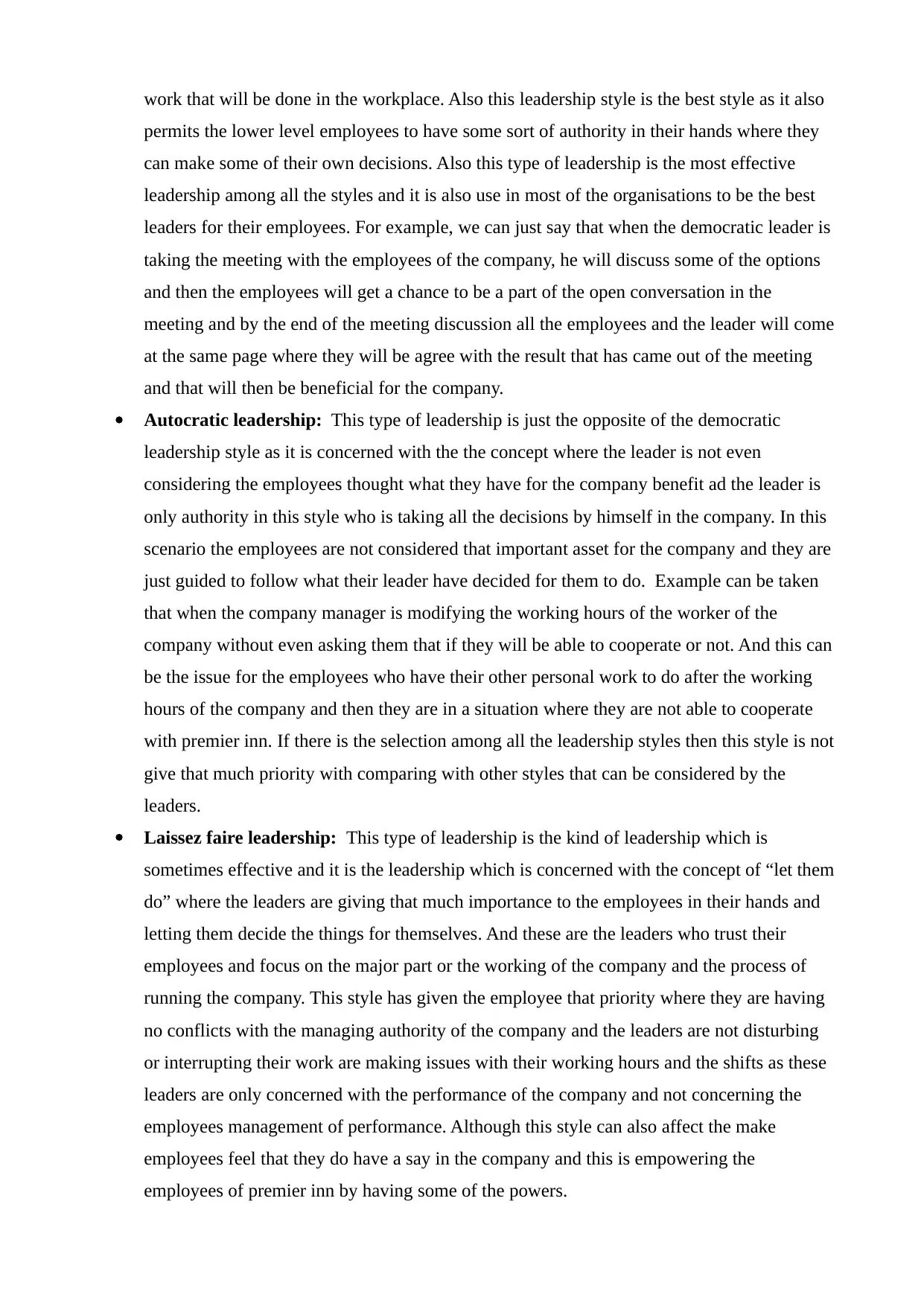
work that will be done in the workplace. Also this leadership style is the best style as it also
permits the lower level employees to have some sort of authority in their hands where they
can make some of their own decisions. Also this type of leadership is the most effective
leadership among all the styles and it is also use in most of the organisations to be the best
leaders for their employees. For example, we can just say that when the democratic leader is
taking the meeting with the employees of the company, he will discuss some of the options
and then the employees will get a chance to be a part of the open conversation in the
meeting and by the end of the meeting discussion all the employees and the leader will come
at the same page where they will be agree with the result that has came out of the meeting
and that will then be beneficial for the company.
Autocratic leadership: This type of leadership is just the opposite of the democratic
leadership style as it is concerned with the the concept where the leader is not even
considering the employees thought what they have for the company benefit ad the leader is
only authority in this style who is taking all the decisions by himself in the company. In this
scenario the employees are not considered that important asset for the company and they are
just guided to follow what their leader have decided for them to do. Example can be taken
that when the company manager is modifying the working hours of the worker of the
company without even asking them that if they will be able to cooperate or not. And this can
be the issue for the employees who have their other personal work to do after the working
hours of the company and then they are in a situation where they are not able to cooperate
with premier inn. If there is the selection among all the leadership styles then this style is not
give that much priority with comparing with other styles that can be considered by the
leaders.
Laissez faire leadership: This type of leadership is the kind of leadership which is
sometimes effective and it is the leadership which is concerned with the concept of “let them
do” where the leaders are giving that much importance to the employees in their hands and
letting them decide the things for themselves. And these are the leaders who trust their
employees and focus on the major part or the working of the company and the process of
running the company. This style has given the employee that priority where they are having
no conflicts with the managing authority of the company and the leaders are not disturbing
or interrupting their work are making issues with their working hours and the shifts as these
leaders are only concerned with the performance of the company and not concerning the
employees management of performance. Although this style can also affect the make
employees feel that they do have a say in the company and this is empowering the
employees of premier inn by having some of the powers.
permits the lower level employees to have some sort of authority in their hands where they
can make some of their own decisions. Also this type of leadership is the most effective
leadership among all the styles and it is also use in most of the organisations to be the best
leaders for their employees. For example, we can just say that when the democratic leader is
taking the meeting with the employees of the company, he will discuss some of the options
and then the employees will get a chance to be a part of the open conversation in the
meeting and by the end of the meeting discussion all the employees and the leader will come
at the same page where they will be agree with the result that has came out of the meeting
and that will then be beneficial for the company.
Autocratic leadership: This type of leadership is just the opposite of the democratic
leadership style as it is concerned with the the concept where the leader is not even
considering the employees thought what they have for the company benefit ad the leader is
only authority in this style who is taking all the decisions by himself in the company. In this
scenario the employees are not considered that important asset for the company and they are
just guided to follow what their leader have decided for them to do. Example can be taken
that when the company manager is modifying the working hours of the worker of the
company without even asking them that if they will be able to cooperate or not. And this can
be the issue for the employees who have their other personal work to do after the working
hours of the company and then they are in a situation where they are not able to cooperate
with premier inn. If there is the selection among all the leadership styles then this style is not
give that much priority with comparing with other styles that can be considered by the
leaders.
Laissez faire leadership: This type of leadership is the kind of leadership which is
sometimes effective and it is the leadership which is concerned with the concept of “let them
do” where the leaders are giving that much importance to the employees in their hands and
letting them decide the things for themselves. And these are the leaders who trust their
employees and focus on the major part or the working of the company and the process of
running the company. This style has given the employee that priority where they are having
no conflicts with the managing authority of the company and the leaders are not disturbing
or interrupting their work are making issues with their working hours and the shifts as these
leaders are only concerned with the performance of the company and not concerning the
employees management of performance. Although this style can also affect the make
employees feel that they do have a say in the company and this is empowering the
employees of premier inn by having some of the powers.
⊘ This is a preview!⊘
Do you want full access?
Subscribe today to unlock all pages.

Trusted by 1+ million students worldwide
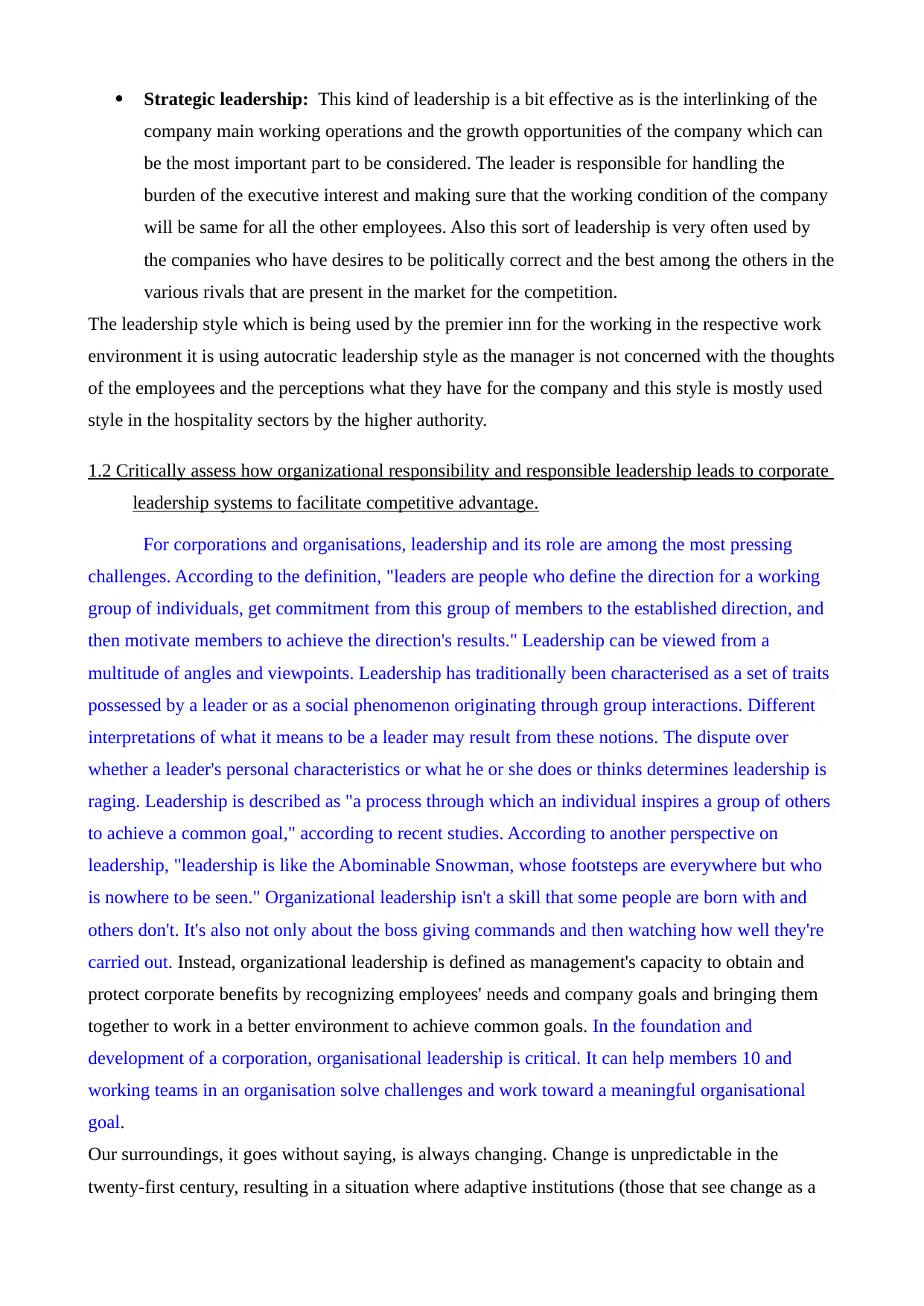
Strategic leadership: This kind of leadership is a bit effective as is the interlinking of the
company main working operations and the growth opportunities of the company which can
be the most important part to be considered. The leader is responsible for handling the
burden of the executive interest and making sure that the working condition of the company
will be same for all the other employees. Also this sort of leadership is very often used by
the companies who have desires to be politically correct and the best among the others in the
various rivals that are present in the market for the competition.
The leadership style which is being used by the premier inn for the working in the respective work
environment it is using autocratic leadership style as the manager is not concerned with the thoughts
of the employees and the perceptions what they have for the company and this style is mostly used
style in the hospitality sectors by the higher authority.
1.2 Critically assess how organizational responsibility and responsible leadership leads to corporate
leadership systems to facilitate competitive advantage.
For corporations and organisations, leadership and its role are among the most pressing
challenges. According to the definition, "leaders are people who define the direction for a working
group of individuals, get commitment from this group of members to the established direction, and
then motivate members to achieve the direction's results." Leadership can be viewed from a
multitude of angles and viewpoints. Leadership has traditionally been characterised as a set of traits
possessed by a leader or as a social phenomenon originating through group interactions. Different
interpretations of what it means to be a leader may result from these notions. The dispute over
whether a leader's personal characteristics or what he or she does or thinks determines leadership is
raging. Leadership is described as "a process through which an individual inspires a group of others
to achieve a common goal," according to recent studies. According to another perspective on
leadership, "leadership is like the Abominable Snowman, whose footsteps are everywhere but who
is nowhere to be seen." Organizational leadership isn't a skill that some people are born with and
others don't. It's also not only about the boss giving commands and then watching how well they're
carried out. Instead, organizational leadership is defined as management's capacity to obtain and
protect corporate benefits by recognizing employees' needs and company goals and bringing them
together to work in a better environment to achieve common goals. In the foundation and
development of a corporation, organisational leadership is critical. It can help members 10 and
working teams in an organisation solve challenges and work toward a meaningful organisational
goal.
Our surroundings, it goes without saying, is always changing. Change is unpredictable in the
twenty-first century, resulting in a situation where adaptive institutions (those that see change as a
company main working operations and the growth opportunities of the company which can
be the most important part to be considered. The leader is responsible for handling the
burden of the executive interest and making sure that the working condition of the company
will be same for all the other employees. Also this sort of leadership is very often used by
the companies who have desires to be politically correct and the best among the others in the
various rivals that are present in the market for the competition.
The leadership style which is being used by the premier inn for the working in the respective work
environment it is using autocratic leadership style as the manager is not concerned with the thoughts
of the employees and the perceptions what they have for the company and this style is mostly used
style in the hospitality sectors by the higher authority.
1.2 Critically assess how organizational responsibility and responsible leadership leads to corporate
leadership systems to facilitate competitive advantage.
For corporations and organisations, leadership and its role are among the most pressing
challenges. According to the definition, "leaders are people who define the direction for a working
group of individuals, get commitment from this group of members to the established direction, and
then motivate members to achieve the direction's results." Leadership can be viewed from a
multitude of angles and viewpoints. Leadership has traditionally been characterised as a set of traits
possessed by a leader or as a social phenomenon originating through group interactions. Different
interpretations of what it means to be a leader may result from these notions. The dispute over
whether a leader's personal characteristics or what he or she does or thinks determines leadership is
raging. Leadership is described as "a process through which an individual inspires a group of others
to achieve a common goal," according to recent studies. According to another perspective on
leadership, "leadership is like the Abominable Snowman, whose footsteps are everywhere but who
is nowhere to be seen." Organizational leadership isn't a skill that some people are born with and
others don't. It's also not only about the boss giving commands and then watching how well they're
carried out. Instead, organizational leadership is defined as management's capacity to obtain and
protect corporate benefits by recognizing employees' needs and company goals and bringing them
together to work in a better environment to achieve common goals. In the foundation and
development of a corporation, organisational leadership is critical. It can help members 10 and
working teams in an organisation solve challenges and work toward a meaningful organisational
goal.
Our surroundings, it goes without saying, is always changing. Change is unpredictable in the
twenty-first century, resulting in a situation where adaptive institutions (those that see change as a
Paraphrase This Document
Need a fresh take? Get an instant paraphrase of this document with our AI Paraphraser
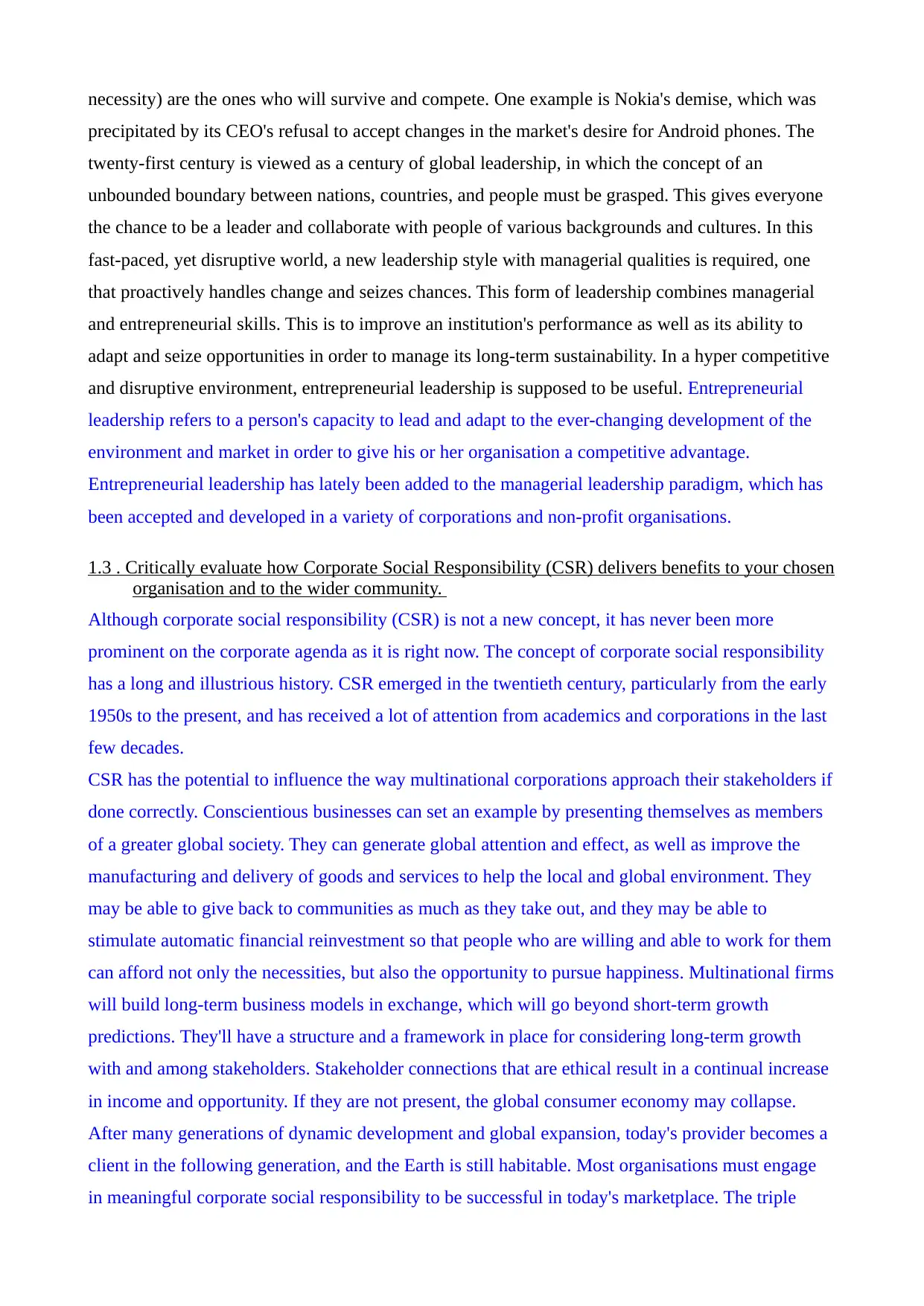
necessity) are the ones who will survive and compete. One example is Nokia's demise, which was
precipitated by its CEO's refusal to accept changes in the market's desire for Android phones. The
twenty-first century is viewed as a century of global leadership, in which the concept of an
unbounded boundary between nations, countries, and people must be grasped. This gives everyone
the chance to be a leader and collaborate with people of various backgrounds and cultures. In this
fast-paced, yet disruptive world, a new leadership style with managerial qualities is required, one
that proactively handles change and seizes chances. This form of leadership combines managerial
and entrepreneurial skills. This is to improve an institution's performance as well as its ability to
adapt and seize opportunities in order to manage its long-term sustainability. In a hyper competitive
and disruptive environment, entrepreneurial leadership is supposed to be useful. Entrepreneurial
leadership refers to a person's capacity to lead and adapt to the ever-changing development of the
environment and market in order to give his or her organisation a competitive advantage.
Entrepreneurial leadership has lately been added to the managerial leadership paradigm, which has
been accepted and developed in a variety of corporations and non-profit organisations.
1.3 . Critically evaluate how Corporate Social Responsibility (CSR) delivers benefits to your chosen
organisation and to the wider community.
Although corporate social responsibility (CSR) is not a new concept, it has never been more
prominent on the corporate agenda as it is right now. The concept of corporate social responsibility
has a long and illustrious history. CSR emerged in the twentieth century, particularly from the early
1950s to the present, and has received a lot of attention from academics and corporations in the last
few decades.
CSR has the potential to influence the way multinational corporations approach their stakeholders if
done correctly. Conscientious businesses can set an example by presenting themselves as members
of a greater global society. They can generate global attention and effect, as well as improve the
manufacturing and delivery of goods and services to help the local and global environment. They
may be able to give back to communities as much as they take out, and they may be able to
stimulate automatic financial reinvestment so that people who are willing and able to work for them
can afford not only the necessities, but also the opportunity to pursue happiness. Multinational firms
will build long-term business models in exchange, which will go beyond short-term growth
predictions. They'll have a structure and a framework in place for considering long-term growth
with and among stakeholders. Stakeholder connections that are ethical result in a continual increase
in income and opportunity. If they are not present, the global consumer economy may collapse.
After many generations of dynamic development and global expansion, today's provider becomes a
client in the following generation, and the Earth is still habitable. Most organisations must engage
in meaningful corporate social responsibility to be successful in today's marketplace. The triple
precipitated by its CEO's refusal to accept changes in the market's desire for Android phones. The
twenty-first century is viewed as a century of global leadership, in which the concept of an
unbounded boundary between nations, countries, and people must be grasped. This gives everyone
the chance to be a leader and collaborate with people of various backgrounds and cultures. In this
fast-paced, yet disruptive world, a new leadership style with managerial qualities is required, one
that proactively handles change and seizes chances. This form of leadership combines managerial
and entrepreneurial skills. This is to improve an institution's performance as well as its ability to
adapt and seize opportunities in order to manage its long-term sustainability. In a hyper competitive
and disruptive environment, entrepreneurial leadership is supposed to be useful. Entrepreneurial
leadership refers to a person's capacity to lead and adapt to the ever-changing development of the
environment and market in order to give his or her organisation a competitive advantage.
Entrepreneurial leadership has lately been added to the managerial leadership paradigm, which has
been accepted and developed in a variety of corporations and non-profit organisations.
1.3 . Critically evaluate how Corporate Social Responsibility (CSR) delivers benefits to your chosen
organisation and to the wider community.
Although corporate social responsibility (CSR) is not a new concept, it has never been more
prominent on the corporate agenda as it is right now. The concept of corporate social responsibility
has a long and illustrious history. CSR emerged in the twentieth century, particularly from the early
1950s to the present, and has received a lot of attention from academics and corporations in the last
few decades.
CSR has the potential to influence the way multinational corporations approach their stakeholders if
done correctly. Conscientious businesses can set an example by presenting themselves as members
of a greater global society. They can generate global attention and effect, as well as improve the
manufacturing and delivery of goods and services to help the local and global environment. They
may be able to give back to communities as much as they take out, and they may be able to
stimulate automatic financial reinvestment so that people who are willing and able to work for them
can afford not only the necessities, but also the opportunity to pursue happiness. Multinational firms
will build long-term business models in exchange, which will go beyond short-term growth
predictions. They'll have a structure and a framework in place for considering long-term growth
with and among stakeholders. Stakeholder connections that are ethical result in a continual increase
in income and opportunity. If they are not present, the global consumer economy may collapse.
After many generations of dynamic development and global expansion, today's provider becomes a
client in the following generation, and the Earth is still habitable. Most organisations must engage
in meaningful corporate social responsibility to be successful in today's marketplace. The triple
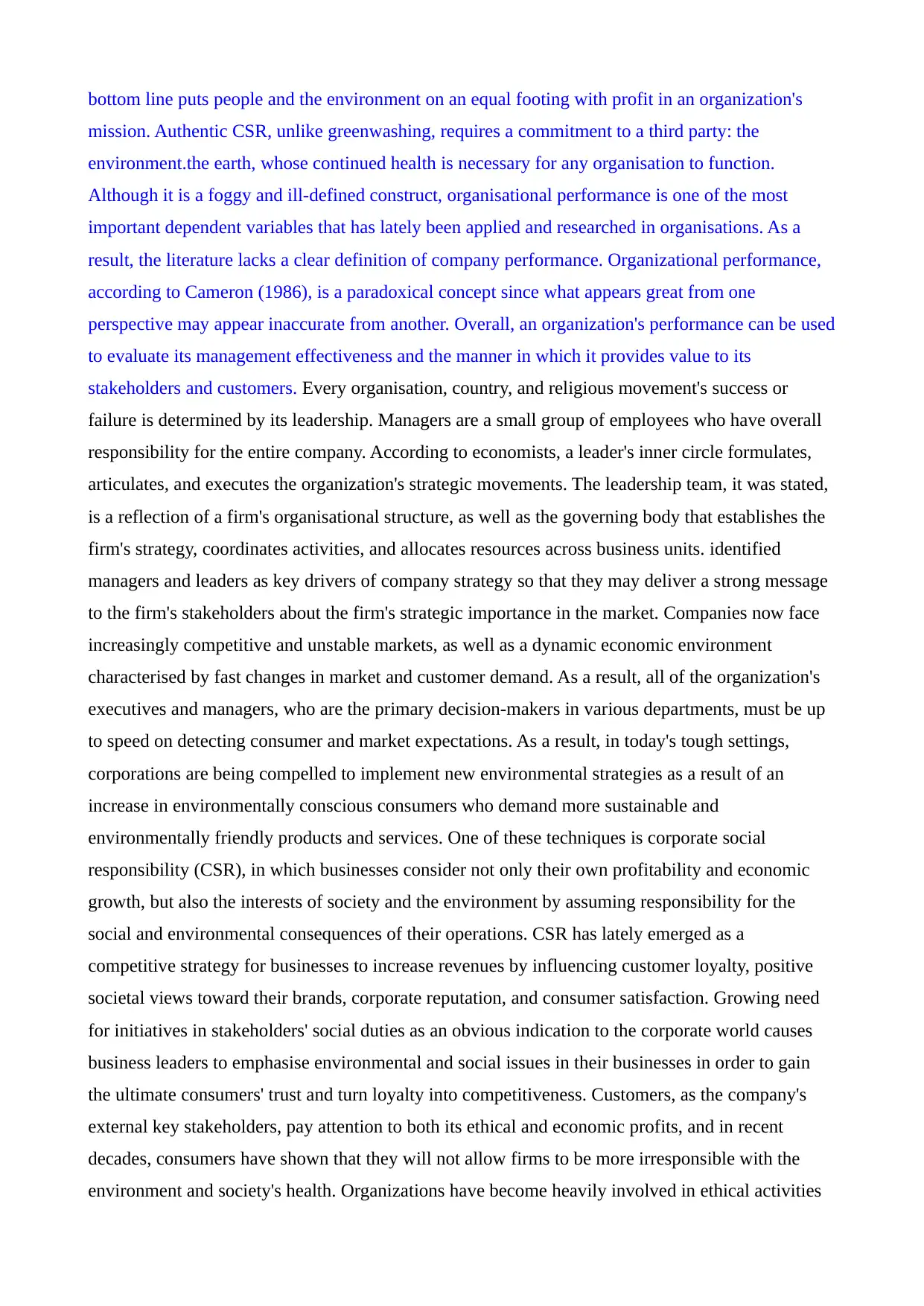
bottom line puts people and the environment on an equal footing with profit in an organization's
mission. Authentic CSR, unlike greenwashing, requires a commitment to a third party: the
environment.the earth, whose continued health is necessary for any organisation to function.
Although it is a foggy and ill-defined construct, organisational performance is one of the most
important dependent variables that has lately been applied and researched in organisations. As a
result, the literature lacks a clear definition of company performance. Organizational performance,
according to Cameron (1986), is a paradoxical concept since what appears great from one
perspective may appear inaccurate from another. Overall, an organization's performance can be used
to evaluate its management effectiveness and the manner in which it provides value to its
stakeholders and customers. Every organisation, country, and religious movement's success or
failure is determined by its leadership. Managers are a small group of employees who have overall
responsibility for the entire company. According to economists, a leader's inner circle formulates,
articulates, and executes the organization's strategic movements. The leadership team, it was stated,
is a reflection of a firm's organisational structure, as well as the governing body that establishes the
firm's strategy, coordinates activities, and allocates resources across business units. identified
managers and leaders as key drivers of company strategy so that they may deliver a strong message
to the firm's stakeholders about the firm's strategic importance in the market. Companies now face
increasingly competitive and unstable markets, as well as a dynamic economic environment
characterised by fast changes in market and customer demand. As a result, all of the organization's
executives and managers, who are the primary decision-makers in various departments, must be up
to speed on detecting consumer and market expectations. As a result, in today's tough settings,
corporations are being compelled to implement new environmental strategies as a result of an
increase in environmentally conscious consumers who demand more sustainable and
environmentally friendly products and services. One of these techniques is corporate social
responsibility (CSR), in which businesses consider not only their own profitability and economic
growth, but also the interests of society and the environment by assuming responsibility for the
social and environmental consequences of their operations. CSR has lately emerged as a
competitive strategy for businesses to increase revenues by influencing customer loyalty, positive
societal views toward their brands, corporate reputation, and consumer satisfaction. Growing need
for initiatives in stakeholders' social duties as an obvious indication to the corporate world causes
business leaders to emphasise environmental and social issues in their businesses in order to gain
the ultimate consumers' trust and turn loyalty into competitiveness. Customers, as the company's
external key stakeholders, pay attention to both its ethical and economic profits, and in recent
decades, consumers have shown that they will not allow firms to be more irresponsible with the
environment and society's health. Organizations have become heavily involved in ethical activities
mission. Authentic CSR, unlike greenwashing, requires a commitment to a third party: the
environment.the earth, whose continued health is necessary for any organisation to function.
Although it is a foggy and ill-defined construct, organisational performance is one of the most
important dependent variables that has lately been applied and researched in organisations. As a
result, the literature lacks a clear definition of company performance. Organizational performance,
according to Cameron (1986), is a paradoxical concept since what appears great from one
perspective may appear inaccurate from another. Overall, an organization's performance can be used
to evaluate its management effectiveness and the manner in which it provides value to its
stakeholders and customers. Every organisation, country, and religious movement's success or
failure is determined by its leadership. Managers are a small group of employees who have overall
responsibility for the entire company. According to economists, a leader's inner circle formulates,
articulates, and executes the organization's strategic movements. The leadership team, it was stated,
is a reflection of a firm's organisational structure, as well as the governing body that establishes the
firm's strategy, coordinates activities, and allocates resources across business units. identified
managers and leaders as key drivers of company strategy so that they may deliver a strong message
to the firm's stakeholders about the firm's strategic importance in the market. Companies now face
increasingly competitive and unstable markets, as well as a dynamic economic environment
characterised by fast changes in market and customer demand. As a result, all of the organization's
executives and managers, who are the primary decision-makers in various departments, must be up
to speed on detecting consumer and market expectations. As a result, in today's tough settings,
corporations are being compelled to implement new environmental strategies as a result of an
increase in environmentally conscious consumers who demand more sustainable and
environmentally friendly products and services. One of these techniques is corporate social
responsibility (CSR), in which businesses consider not only their own profitability and economic
growth, but also the interests of society and the environment by assuming responsibility for the
social and environmental consequences of their operations. CSR has lately emerged as a
competitive strategy for businesses to increase revenues by influencing customer loyalty, positive
societal views toward their brands, corporate reputation, and consumer satisfaction. Growing need
for initiatives in stakeholders' social duties as an obvious indication to the corporate world causes
business leaders to emphasise environmental and social issues in their businesses in order to gain
the ultimate consumers' trust and turn loyalty into competitiveness. Customers, as the company's
external key stakeholders, pay attention to both its ethical and economic profits, and in recent
decades, consumers have shown that they will not allow firms to be more irresponsible with the
environment and society's health. Organizations have become heavily involved in ethical activities
⊘ This is a preview!⊘
Do you want full access?
Subscribe today to unlock all pages.

Trusted by 1+ million students worldwide
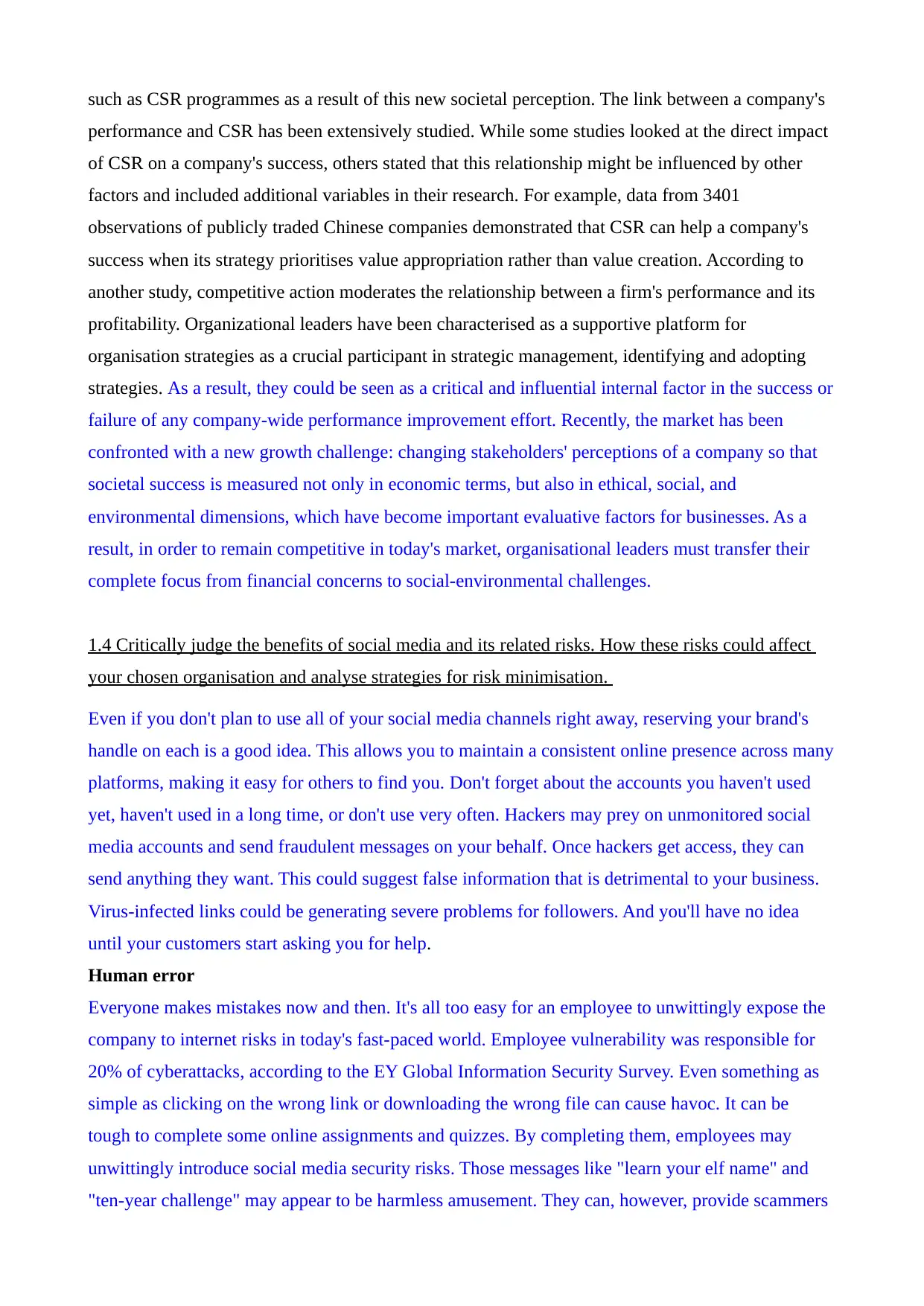
such as CSR programmes as a result of this new societal perception. The link between a company's
performance and CSR has been extensively studied. While some studies looked at the direct impact
of CSR on a company's success, others stated that this relationship might be influenced by other
factors and included additional variables in their research. For example, data from 3401
observations of publicly traded Chinese companies demonstrated that CSR can help a company's
success when its strategy prioritises value appropriation rather than value creation. According to
another study, competitive action moderates the relationship between a firm's performance and its
profitability. Organizational leaders have been characterised as a supportive platform for
organisation strategies as a crucial participant in strategic management, identifying and adopting
strategies. As a result, they could be seen as a critical and influential internal factor in the success or
failure of any company-wide performance improvement effort. Recently, the market has been
confronted with a new growth challenge: changing stakeholders' perceptions of a company so that
societal success is measured not only in economic terms, but also in ethical, social, and
environmental dimensions, which have become important evaluative factors for businesses. As a
result, in order to remain competitive in today's market, organisational leaders must transfer their
complete focus from financial concerns to social-environmental challenges.
1.4 Critically judge the benefits of social media and its related risks. How these risks could affect
your chosen organisation and analyse strategies for risk minimisation.
Even if you don't plan to use all of your social media channels right away, reserving your brand's
handle on each is a good idea. This allows you to maintain a consistent online presence across many
platforms, making it easy for others to find you. Don't forget about the accounts you haven't used
yet, haven't used in a long time, or don't use very often. Hackers may prey on unmonitored social
media accounts and send fraudulent messages on your behalf. Once hackers get access, they can
send anything they want. This could suggest false information that is detrimental to your business.
Virus-infected links could be generating severe problems for followers. And you'll have no idea
until your customers start asking you for help.
Human error
Everyone makes mistakes now and then. It's all too easy for an employee to unwittingly expose the
company to internet risks in today's fast-paced world. Employee vulnerability was responsible for
20% of cyberattacks, according to the EY Global Information Security Survey. Even something as
simple as clicking on the wrong link or downloading the wrong file can cause havoc. It can be
tough to complete some online assignments and quizzes. By completing them, employees may
unwittingly introduce social media security risks. Those messages like "learn your elf name" and
"ten-year challenge" may appear to be harmless amusement. They can, however, provide scammers
performance and CSR has been extensively studied. While some studies looked at the direct impact
of CSR on a company's success, others stated that this relationship might be influenced by other
factors and included additional variables in their research. For example, data from 3401
observations of publicly traded Chinese companies demonstrated that CSR can help a company's
success when its strategy prioritises value appropriation rather than value creation. According to
another study, competitive action moderates the relationship between a firm's performance and its
profitability. Organizational leaders have been characterised as a supportive platform for
organisation strategies as a crucial participant in strategic management, identifying and adopting
strategies. As a result, they could be seen as a critical and influential internal factor in the success or
failure of any company-wide performance improvement effort. Recently, the market has been
confronted with a new growth challenge: changing stakeholders' perceptions of a company so that
societal success is measured not only in economic terms, but also in ethical, social, and
environmental dimensions, which have become important evaluative factors for businesses. As a
result, in order to remain competitive in today's market, organisational leaders must transfer their
complete focus from financial concerns to social-environmental challenges.
1.4 Critically judge the benefits of social media and its related risks. How these risks could affect
your chosen organisation and analyse strategies for risk minimisation.
Even if you don't plan to use all of your social media channels right away, reserving your brand's
handle on each is a good idea. This allows you to maintain a consistent online presence across many
platforms, making it easy for others to find you. Don't forget about the accounts you haven't used
yet, haven't used in a long time, or don't use very often. Hackers may prey on unmonitored social
media accounts and send fraudulent messages on your behalf. Once hackers get access, they can
send anything they want. This could suggest false information that is detrimental to your business.
Virus-infected links could be generating severe problems for followers. And you'll have no idea
until your customers start asking you for help.
Human error
Everyone makes mistakes now and then. It's all too easy for an employee to unwittingly expose the
company to internet risks in today's fast-paced world. Employee vulnerability was responsible for
20% of cyberattacks, according to the EY Global Information Security Survey. Even something as
simple as clicking on the wrong link or downloading the wrong file can cause havoc. It can be
tough to complete some online assignments and quizzes. By completing them, employees may
unwittingly introduce social media security risks. Those messages like "learn your elf name" and
"ten-year challenge" may appear to be harmless amusement. They can, however, provide scammers
Paraphrase This Document
Need a fresh take? Get an instant paraphrase of this document with our AI Paraphraser
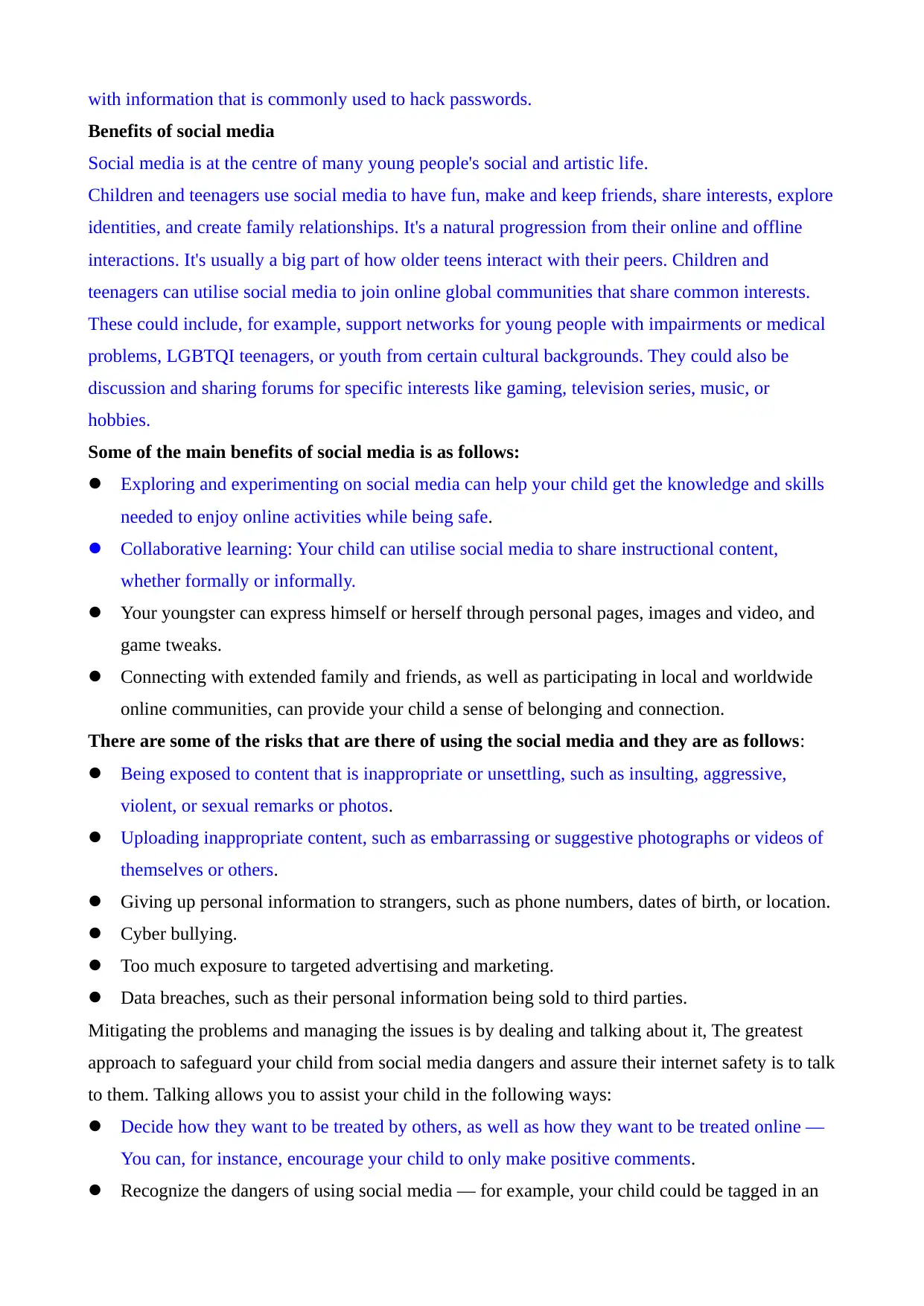
with information that is commonly used to hack passwords.
Benefits of social media
Social media is at the centre of many young people's social and artistic life.
Children and teenagers use social media to have fun, make and keep friends, share interests, explore
identities, and create family relationships. It's a natural progression from their online and offline
interactions. It's usually a big part of how older teens interact with their peers. Children and
teenagers can utilise social media to join online global communities that share common interests.
These could include, for example, support networks for young people with impairments or medical
problems, LGBTQI teenagers, or youth from certain cultural backgrounds. They could also be
discussion and sharing forums for specific interests like gaming, television series, music, or
hobbies.
Some of the main benefits of social media is as follows:
Exploring and experimenting on social media can help your child get the knowledge and skills
needed to enjoy online activities while being safe.
Collaborative learning: Your child can utilise social media to share instructional content,
whether formally or informally.
Your youngster can express himself or herself through personal pages, images and video, and
game tweaks.
Connecting with extended family and friends, as well as participating in local and worldwide
online communities, can provide your child a sense of belonging and connection.
There are some of the risks that are there of using the social media and they are as follows:
Being exposed to content that is inappropriate or unsettling, such as insulting, aggressive,
violent, or sexual remarks or photos.
Uploading inappropriate content, such as embarrassing or suggestive photographs or videos of
themselves or others.
Giving up personal information to strangers, such as phone numbers, dates of birth, or location.
Cyber bullying.
Too much exposure to targeted advertising and marketing.
Data breaches, such as their personal information being sold to third parties.
Mitigating the problems and managing the issues is by dealing and talking about it, The greatest
approach to safeguard your child from social media dangers and assure their internet safety is to talk
to them. Talking allows you to assist your child in the following ways:
Decide how they want to be treated by others, as well as how they want to be treated online —
You can, for instance, encourage your child to only make positive comments.
Recognize the dangers of using social media — for example, your child could be tagged in an
Benefits of social media
Social media is at the centre of many young people's social and artistic life.
Children and teenagers use social media to have fun, make and keep friends, share interests, explore
identities, and create family relationships. It's a natural progression from their online and offline
interactions. It's usually a big part of how older teens interact with their peers. Children and
teenagers can utilise social media to join online global communities that share common interests.
These could include, for example, support networks for young people with impairments or medical
problems, LGBTQI teenagers, or youth from certain cultural backgrounds. They could also be
discussion and sharing forums for specific interests like gaming, television series, music, or
hobbies.
Some of the main benefits of social media is as follows:
Exploring and experimenting on social media can help your child get the knowledge and skills
needed to enjoy online activities while being safe.
Collaborative learning: Your child can utilise social media to share instructional content,
whether formally or informally.
Your youngster can express himself or herself through personal pages, images and video, and
game tweaks.
Connecting with extended family and friends, as well as participating in local and worldwide
online communities, can provide your child a sense of belonging and connection.
There are some of the risks that are there of using the social media and they are as follows:
Being exposed to content that is inappropriate or unsettling, such as insulting, aggressive,
violent, or sexual remarks or photos.
Uploading inappropriate content, such as embarrassing or suggestive photographs or videos of
themselves or others.
Giving up personal information to strangers, such as phone numbers, dates of birth, or location.
Cyber bullying.
Too much exposure to targeted advertising and marketing.
Data breaches, such as their personal information being sold to third parties.
Mitigating the problems and managing the issues is by dealing and talking about it, The greatest
approach to safeguard your child from social media dangers and assure their internet safety is to talk
to them. Talking allows you to assist your child in the following ways:
Decide how they want to be treated by others, as well as how they want to be treated online —
You can, for instance, encourage your child to only make positive comments.
Recognize the dangers of using social media — for example, your child could be tagged in an
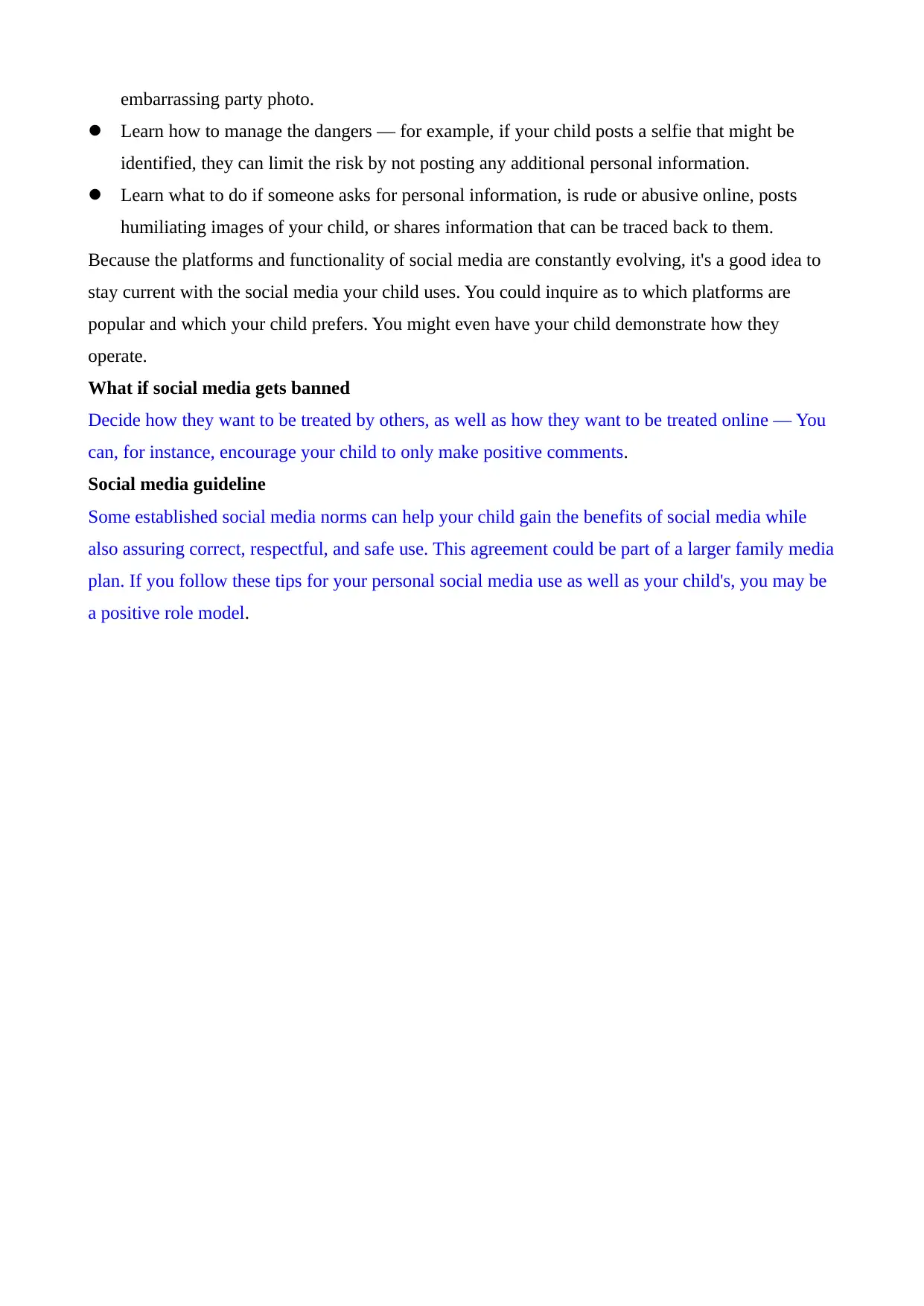
embarrassing party photo.
Learn how to manage the dangers — for example, if your child posts a selfie that might be
identified, they can limit the risk by not posting any additional personal information.
Learn what to do if someone asks for personal information, is rude or abusive online, posts
humiliating images of your child, or shares information that can be traced back to them.
Because the platforms and functionality of social media are constantly evolving, it's a good idea to
stay current with the social media your child uses. You could inquire as to which platforms are
popular and which your child prefers. You might even have your child demonstrate how they
operate.
What if social media gets banned
Decide how they want to be treated by others, as well as how they want to be treated online — You
can, for instance, encourage your child to only make positive comments.
Social media guideline
Some established social media norms can help your child gain the benefits of social media while
also assuring correct, respectful, and safe use. This agreement could be part of a larger family media
plan. If you follow these tips for your personal social media use as well as your child's, you may be
a positive role model.
Learn how to manage the dangers — for example, if your child posts a selfie that might be
identified, they can limit the risk by not posting any additional personal information.
Learn what to do if someone asks for personal information, is rude or abusive online, posts
humiliating images of your child, or shares information that can be traced back to them.
Because the platforms and functionality of social media are constantly evolving, it's a good idea to
stay current with the social media your child uses. You could inquire as to which platforms are
popular and which your child prefers. You might even have your child demonstrate how they
operate.
What if social media gets banned
Decide how they want to be treated by others, as well as how they want to be treated online — You
can, for instance, encourage your child to only make positive comments.
Social media guideline
Some established social media norms can help your child gain the benefits of social media while
also assuring correct, respectful, and safe use. This agreement could be part of a larger family media
plan. If you follow these tips for your personal social media use as well as your child's, you may be
a positive role model.
⊘ This is a preview!⊘
Do you want full access?
Subscribe today to unlock all pages.

Trusted by 1+ million students worldwide
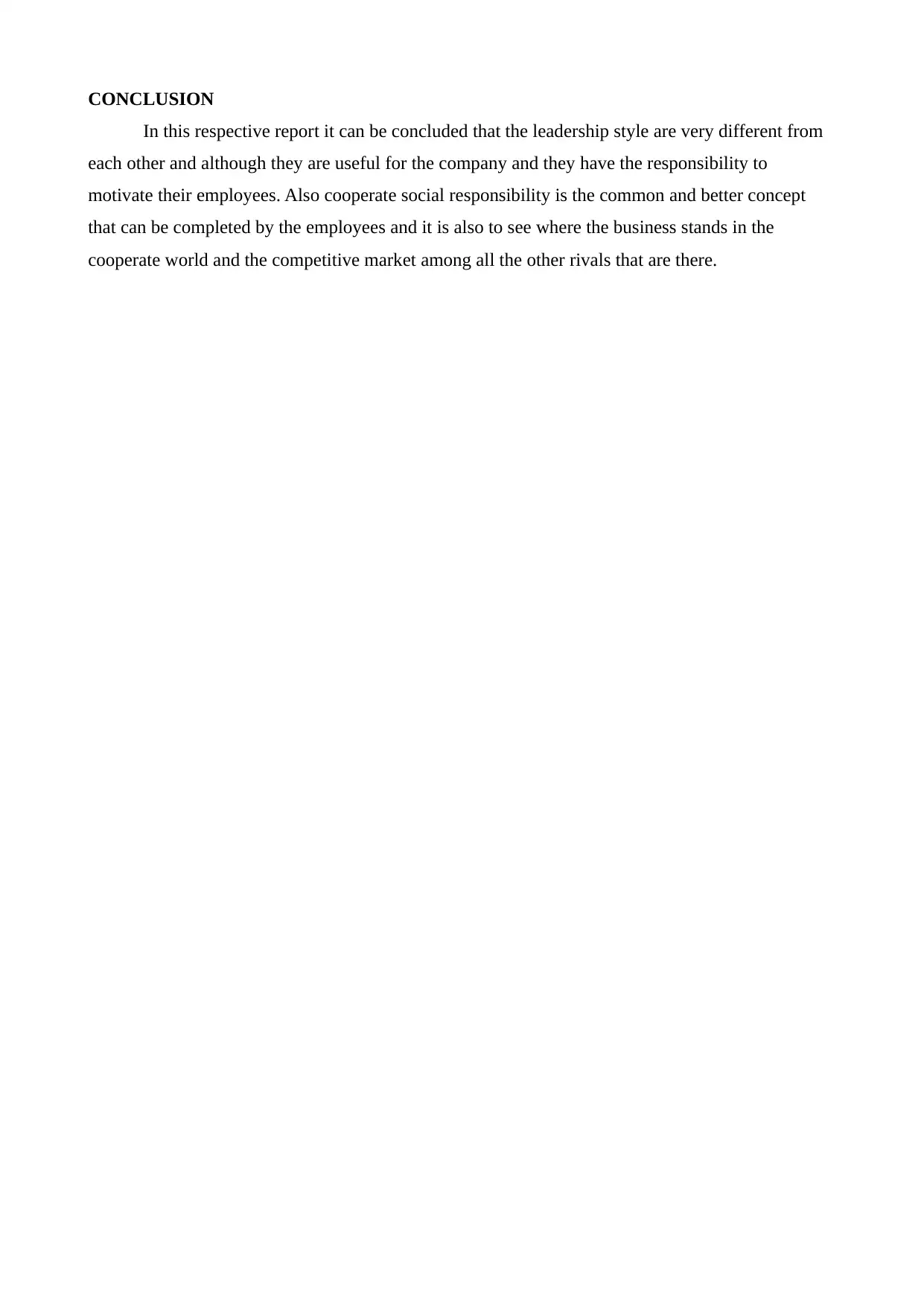
CONCLUSION
In this respective report it can be concluded that the leadership style are very different from
each other and although they are useful for the company and they have the responsibility to
motivate their employees. Also cooperate social responsibility is the common and better concept
that can be completed by the employees and it is also to see where the business stands in the
cooperate world and the competitive market among all the other rivals that are there.
In this respective report it can be concluded that the leadership style are very different from
each other and although they are useful for the company and they have the responsibility to
motivate their employees. Also cooperate social responsibility is the common and better concept
that can be completed by the employees and it is also to see where the business stands in the
cooperate world and the competitive market among all the other rivals that are there.
Paraphrase This Document
Need a fresh take? Get an instant paraphrase of this document with our AI Paraphraser
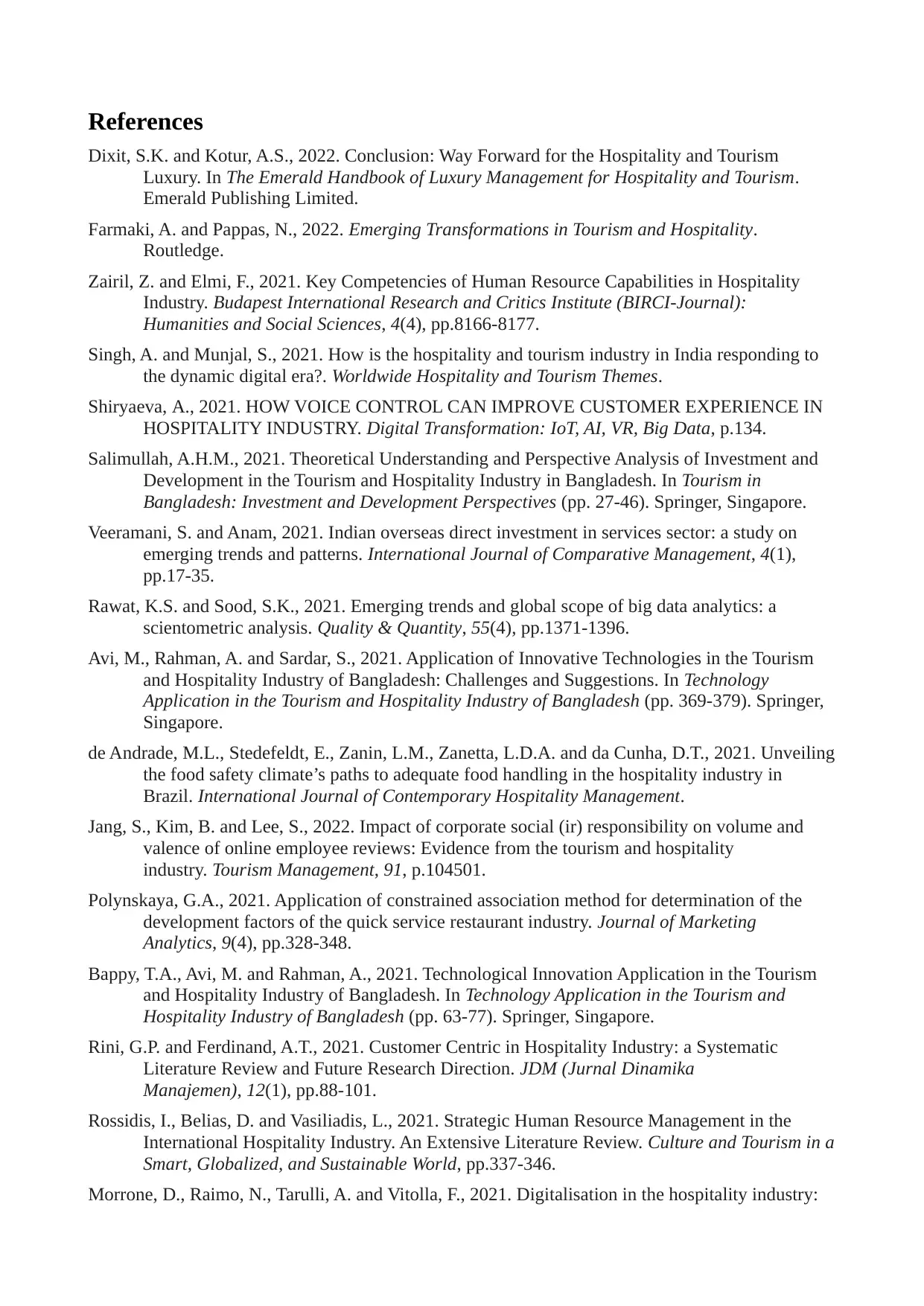
References
Dixit, S.K. and Kotur, A.S., 2022. Conclusion: Way Forward for the Hospitality and Tourism
Luxury. In The Emerald Handbook of Luxury Management for Hospitality and Tourism.
Emerald Publishing Limited.
Farmaki, A. and Pappas, N., 2022. Emerging Transformations in Tourism and Hospitality.
Routledge.
Zairil, Z. and Elmi, F., 2021. Key Competencies of Human Resource Capabilities in Hospitality
Industry. Budapest International Research and Critics Institute (BIRCI-Journal):
Humanities and Social Sciences, 4(4), pp.8166-8177.
Singh, A. and Munjal, S., 2021. How is the hospitality and tourism industry in India responding to
the dynamic digital era?. Worldwide Hospitality and Tourism Themes.
Shiryaeva, А., 2021. HOW VOICE CONTROL CAN IMPROVE CUSTOMER EXPERIENCE IN
HOSPITALITY INDUSTRY. Digital Transformation: IoT, AI, VR, Big Data, p.134.
Salimullah, A.H.M., 2021. Theoretical Understanding and Perspective Analysis of Investment and
Development in the Tourism and Hospitality Industry in Bangladesh. In Tourism in
Bangladesh: Investment and Development Perspectives (pp. 27-46). Springer, Singapore.
Veeramani, S. and Anam, 2021. Indian overseas direct investment in services sector: a study on
emerging trends and patterns. International Journal of Comparative Management, 4(1),
pp.17-35.
Rawat, K.S. and Sood, S.K., 2021. Emerging trends and global scope of big data analytics: a
scientometric analysis. Quality & Quantity, 55(4), pp.1371-1396.
Avi, M., Rahman, A. and Sardar, S., 2021. Application of Innovative Technologies in the Tourism
and Hospitality Industry of Bangladesh: Challenges and Suggestions. In Technology
Application in the Tourism and Hospitality Industry of Bangladesh (pp. 369-379). Springer,
Singapore.
de Andrade, M.L., Stedefeldt, E., Zanin, L.M., Zanetta, L.D.A. and da Cunha, D.T., 2021. Unveiling
the food safety climate’s paths to adequate food handling in the hospitality industry in
Brazil. International Journal of Contemporary Hospitality Management.
Jang, S., Kim, B. and Lee, S., 2022. Impact of corporate social (ir) responsibility on volume and
valence of online employee reviews: Evidence from the tourism and hospitality
industry. Tourism Management, 91, p.104501.
Polynskaya, G.A., 2021. Application of constrained association method for determination of the
development factors of the quick service restaurant industry. Journal of Marketing
Analytics, 9(4), pp.328-348.
Bappy, T.A., Avi, M. and Rahman, A., 2021. Technological Innovation Application in the Tourism
and Hospitality Industry of Bangladesh. In Technology Application in the Tourism and
Hospitality Industry of Bangladesh (pp. 63-77). Springer, Singapore.
Rini, G.P. and Ferdinand, A.T., 2021. Customer Centric in Hospitality Industry: a Systematic
Literature Review and Future Research Direction. JDM (Jurnal Dinamika
Manajemen), 12(1), pp.88-101.
Rossidis, I., Belias, D. and Vasiliadis, L., 2021. Strategic Human Resource Management in the
International Hospitality Industry. An Extensive Literature Review. Culture and Tourism in a
Smart, Globalized, and Sustainable World, pp.337-346.
Morrone, D., Raimo, N., Tarulli, A. and Vitolla, F., 2021. Digitalisation in the hospitality industry:
Dixit, S.K. and Kotur, A.S., 2022. Conclusion: Way Forward for the Hospitality and Tourism
Luxury. In The Emerald Handbook of Luxury Management for Hospitality and Tourism.
Emerald Publishing Limited.
Farmaki, A. and Pappas, N., 2022. Emerging Transformations in Tourism and Hospitality.
Routledge.
Zairil, Z. and Elmi, F., 2021. Key Competencies of Human Resource Capabilities in Hospitality
Industry. Budapest International Research and Critics Institute (BIRCI-Journal):
Humanities and Social Sciences, 4(4), pp.8166-8177.
Singh, A. and Munjal, S., 2021. How is the hospitality and tourism industry in India responding to
the dynamic digital era?. Worldwide Hospitality and Tourism Themes.
Shiryaeva, А., 2021. HOW VOICE CONTROL CAN IMPROVE CUSTOMER EXPERIENCE IN
HOSPITALITY INDUSTRY. Digital Transformation: IoT, AI, VR, Big Data, p.134.
Salimullah, A.H.M., 2021. Theoretical Understanding and Perspective Analysis of Investment and
Development in the Tourism and Hospitality Industry in Bangladesh. In Tourism in
Bangladesh: Investment and Development Perspectives (pp. 27-46). Springer, Singapore.
Veeramani, S. and Anam, 2021. Indian overseas direct investment in services sector: a study on
emerging trends and patterns. International Journal of Comparative Management, 4(1),
pp.17-35.
Rawat, K.S. and Sood, S.K., 2021. Emerging trends and global scope of big data analytics: a
scientometric analysis. Quality & Quantity, 55(4), pp.1371-1396.
Avi, M., Rahman, A. and Sardar, S., 2021. Application of Innovative Technologies in the Tourism
and Hospitality Industry of Bangladesh: Challenges and Suggestions. In Technology
Application in the Tourism and Hospitality Industry of Bangladesh (pp. 369-379). Springer,
Singapore.
de Andrade, M.L., Stedefeldt, E., Zanin, L.M., Zanetta, L.D.A. and da Cunha, D.T., 2021. Unveiling
the food safety climate’s paths to adequate food handling in the hospitality industry in
Brazil. International Journal of Contemporary Hospitality Management.
Jang, S., Kim, B. and Lee, S., 2022. Impact of corporate social (ir) responsibility on volume and
valence of online employee reviews: Evidence from the tourism and hospitality
industry. Tourism Management, 91, p.104501.
Polynskaya, G.A., 2021. Application of constrained association method for determination of the
development factors of the quick service restaurant industry. Journal of Marketing
Analytics, 9(4), pp.328-348.
Bappy, T.A., Avi, M. and Rahman, A., 2021. Technological Innovation Application in the Tourism
and Hospitality Industry of Bangladesh. In Technology Application in the Tourism and
Hospitality Industry of Bangladesh (pp. 63-77). Springer, Singapore.
Rini, G.P. and Ferdinand, A.T., 2021. Customer Centric in Hospitality Industry: a Systematic
Literature Review and Future Research Direction. JDM (Jurnal Dinamika
Manajemen), 12(1), pp.88-101.
Rossidis, I., Belias, D. and Vasiliadis, L., 2021. Strategic Human Resource Management in the
International Hospitality Industry. An Extensive Literature Review. Culture and Tourism in a
Smart, Globalized, and Sustainable World, pp.337-346.
Morrone, D., Raimo, N., Tarulli, A. and Vitolla, F., 2021. Digitalisation in the hospitality industry:
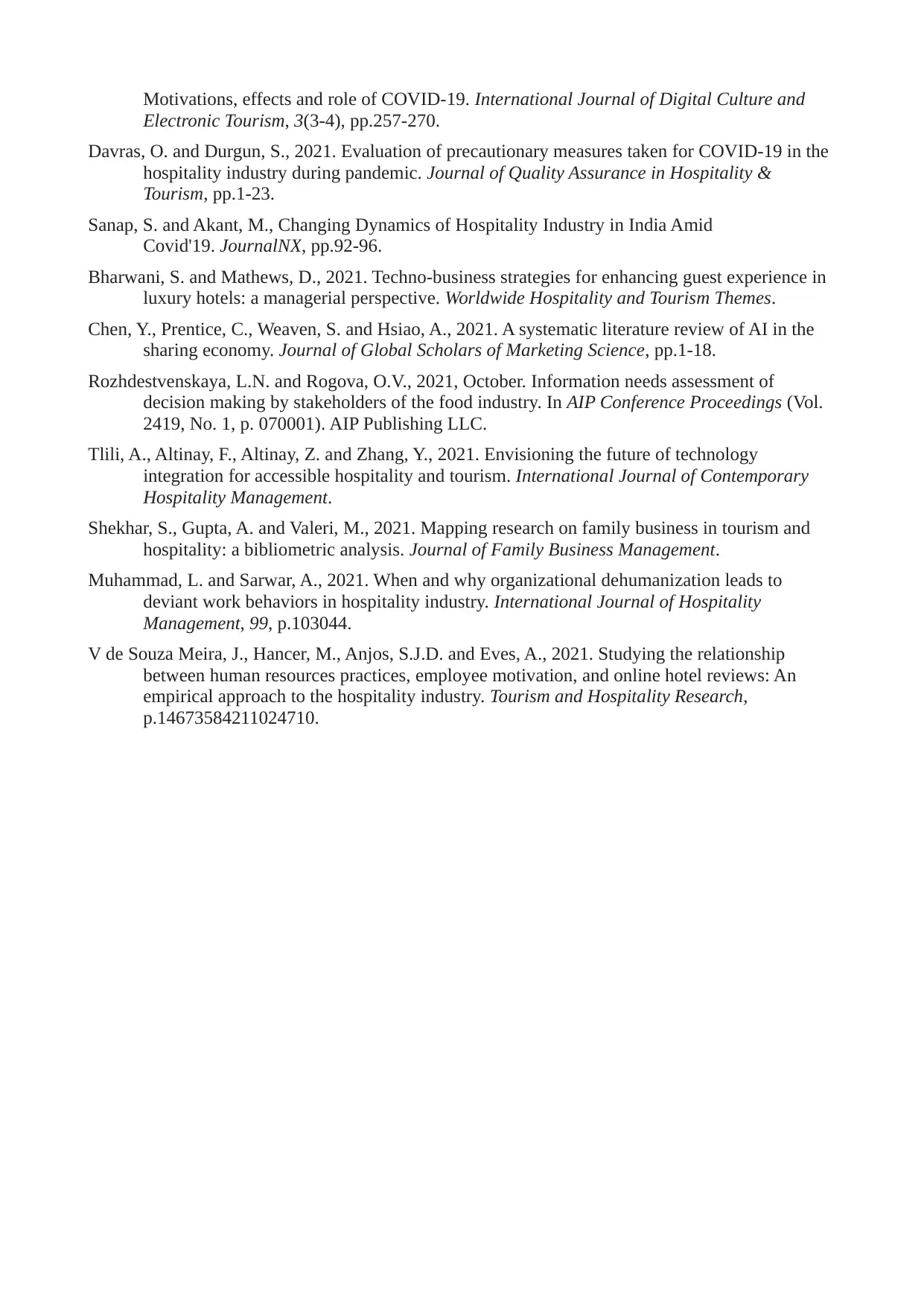
Motivations, effects and role of COVID-19. International Journal of Digital Culture and
Electronic Tourism, 3(3-4), pp.257-270.
Davras, O. and Durgun, S., 2021. Evaluation of precautionary measures taken for COVID-19 in the
hospitality industry during pandemic. Journal of Quality Assurance in Hospitality &
Tourism, pp.1-23.
Sanap, S. and Akant, M., Changing Dynamics of Hospitality Industry in India Amid
Covid'19. JournalNX, pp.92-96.
Bharwani, S. and Mathews, D., 2021. Techno-business strategies for enhancing guest experience in
luxury hotels: a managerial perspective. Worldwide Hospitality and Tourism Themes.
Chen, Y., Prentice, C., Weaven, S. and Hsiao, A., 2021. A systematic literature review of AI in the
sharing economy. Journal of Global Scholars of Marketing Science, pp.1-18.
Rozhdestvenskaya, L.N. and Rogova, O.V., 2021, October. Information needs assessment of
decision making by stakeholders of the food industry. In AIP Conference Proceedings (Vol.
2419, No. 1, p. 070001). AIP Publishing LLC.
Tlili, A., Altinay, F., Altinay, Z. and Zhang, Y., 2021. Envisioning the future of technology
integration for accessible hospitality and tourism. International Journal of Contemporary
Hospitality Management.
Shekhar, S., Gupta, A. and Valeri, M., 2021. Mapping research on family business in tourism and
hospitality: a bibliometric analysis. Journal of Family Business Management.
Muhammad, L. and Sarwar, A., 2021. When and why organizational dehumanization leads to
deviant work behaviors in hospitality industry. International Journal of Hospitality
Management, 99, p.103044.
V de Souza Meira, J., Hancer, M., Anjos, S.J.D. and Eves, A., 2021. Studying the relationship
between human resources practices, employee motivation, and online hotel reviews: An
empirical approach to the hospitality industry. Tourism and Hospitality Research,
p.14673584211024710.
Electronic Tourism, 3(3-4), pp.257-270.
Davras, O. and Durgun, S., 2021. Evaluation of precautionary measures taken for COVID-19 in the
hospitality industry during pandemic. Journal of Quality Assurance in Hospitality &
Tourism, pp.1-23.
Sanap, S. and Akant, M., Changing Dynamics of Hospitality Industry in India Amid
Covid'19. JournalNX, pp.92-96.
Bharwani, S. and Mathews, D., 2021. Techno-business strategies for enhancing guest experience in
luxury hotels: a managerial perspective. Worldwide Hospitality and Tourism Themes.
Chen, Y., Prentice, C., Weaven, S. and Hsiao, A., 2021. A systematic literature review of AI in the
sharing economy. Journal of Global Scholars of Marketing Science, pp.1-18.
Rozhdestvenskaya, L.N. and Rogova, O.V., 2021, October. Information needs assessment of
decision making by stakeholders of the food industry. In AIP Conference Proceedings (Vol.
2419, No. 1, p. 070001). AIP Publishing LLC.
Tlili, A., Altinay, F., Altinay, Z. and Zhang, Y., 2021. Envisioning the future of technology
integration for accessible hospitality and tourism. International Journal of Contemporary
Hospitality Management.
Shekhar, S., Gupta, A. and Valeri, M., 2021. Mapping research on family business in tourism and
hospitality: a bibliometric analysis. Journal of Family Business Management.
Muhammad, L. and Sarwar, A., 2021. When and why organizational dehumanization leads to
deviant work behaviors in hospitality industry. International Journal of Hospitality
Management, 99, p.103044.
V de Souza Meira, J., Hancer, M., Anjos, S.J.D. and Eves, A., 2021. Studying the relationship
between human resources practices, employee motivation, and online hotel reviews: An
empirical approach to the hospitality industry. Tourism and Hospitality Research,
p.14673584211024710.
⊘ This is a preview!⊘
Do you want full access?
Subscribe today to unlock all pages.

Trusted by 1+ million students worldwide
1 out of 12
Related Documents
Your All-in-One AI-Powered Toolkit for Academic Success.
+13062052269
info@desklib.com
Available 24*7 on WhatsApp / Email
![[object Object]](/_next/static/media/star-bottom.7253800d.svg)
Unlock your academic potential
Copyright © 2020–2025 A2Z Services. All Rights Reserved. Developed and managed by ZUCOL.



